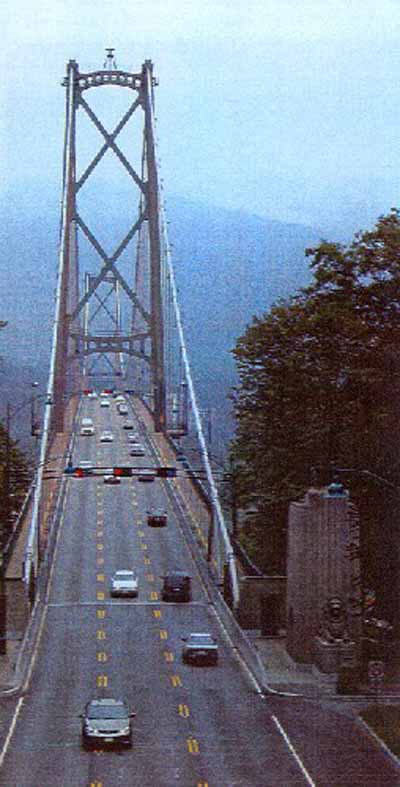Lions Gate Bridge National Historic Site of Canada
Vancouver, British Columbia

General view
© Parks Canada Agency / Agence Parcs Canada, Judith Dufresne, 2003.
Address :
Lions Gate Bridge Road, Highway 1A/99A, Vancouver, British Columbia
Recognition Statute:
Historic Sites and Monuments Act (R.S.C., 1985, c. H-4)
Designation Date:
2004-12-10
Dates:
-
1937 to 1938
(Construction)
-
1999 to 2001
(Significant)
Event, Person, Organization:
-
Monsarrat and Pratley
(Architect)
-
W.G. Swan
(Architect)
-
Robinson & Steinman
(Architect)
Other Name(s):
-
Lions Gate Bridge
(Designation Name)
Research Report Number:
2003-047
Plaque(s)
Approved Inscription: Lions Gate Bridge Road, Highway 1A/99A, Vancouver, British Columbia
This remarkable suspension bridge, towering over the waters of Burrard Inlet, is distinguished by an elegant design that complements a spectacular mountain setting. Designed by the firm of Monsarrat & Pratley, the Lions Gate Bridge was recognized from the time of its completion in 1938 as an engineering feat, with its impressive span and such advanced features as a thin road deck and prefabricated cable strands. Built to facilitate the development of West Vancouver, the bridge quickly became a major landmark and acquired symbolic importance as the western gateway to Canada.
Approved 2007
Description of Historic Place
Located in Vancouver, the Lions Gate Bridge National Historic Site of Canada is the longest suspension bridge in Western Canada with a total length (including approach spans) of 1517 metres. The bridge has three traffic lanes, an electronic signage system and a pedestrian and cyclist sidewalk on either side of the deck. It serves as a major transportation link for communities throughout the region on both sides of Burrard Inlet. The site includes the south entrance to the bridge that emerges from Stanley Park National Historic Site of Canada, near Prospect, the main span, which is supported by twin towers, and the viaduct on the north shore located in a land corridor that crosses Capilano Indian Reserve.
Heritage Value
The Lions Gate Bridge was designated a National Historic Site of Canada in 2004 because: it is an outstanding landmark and has a significant symbolic value to Canadians; it is distinctive by its elegant design which complements a spectacular setting; it is an outstanding engineering achievement for its time in its advanced technical features; and, it had an undeniable and significant influence on the development of Vancouver.
Identified as one of Canada’s technical and engineering landmarks, the Lions Gate Bridge is noted for its innovative civil engineering. When built it was recognized as the longest suspension bridge in the British Empire and one of the biggest construction projects undertaken in Canada during the 1930s. Despite its enormous size, the open steelwork of the twin towers and pioneering use of a thin deck gave the structure a light weightless quality that blend well with its picturesque setting. The bridge was remarkable because of its length and the technical innovations in cable use and construction. The reconstruction of its deck at the turn of the twenty-first century was also an exceptional achievement, marking the first time that the deck, hangers and stiffening trusses of a suspension bridge were replaced simultaneously without closing the bridge to traffic.
The bridge stimulated the geographic and socio-economic development of the north shore of Vancouver. Financed by the brewing tycoon, Sir Arthur Guinness, through a syndicate called British Pacific Properties Ltd., the Lions Gate Bridge was commissioned to open up the suburbs of West Vancouver for development by establishing a direct link between Vancouver and the north shore of the First Narrows of Burrard Inlet. The design of the bridge owed much to the vision of Victoria-born Alfred J.T. Taylor, a prominent engineering contractor and industrialist who had substantial land holdings on the north shore and who assembled the financing for the project.
Despite upgrades due to increased traffic flow and seismic concerns, the integrity of its aesthetic design and the treatment of materials have been maintained.
Source: Historic Sites and Monuments Board of Canada, Minutes, December 2003.
Character-Defining Elements
Key elements that define the heritage character of the Lions Gate Bridge include: its setting at the entrance to the Port of Vancouver, spanning the First Narrows from Stanley Park to the north shore with the backdrop of the Coastal Mountain Range; its form, scale and massing as expressed by its long, elegant form and large scale; its twin, tapered open work towers that consist of sections of flat and angled steel; its narrow stiffening trusses and thin deck; its reinforced concrete suspension cable anchors; its innovative steel-sheathed suspension cables consisting of galvanized wires in a hexagonal configuration filled with treated cedar strapping to form a round section covered with a continuous galvanized mild steel sheath; that each upright has a middle caisson the dimensions of which are constant and two side caissons that narrow from the base to the top; both uprights are stiffened by internal diaphragms and have cross bracing and diagonal bracing to withstand lateral loads; its pylons, sculptural bases and surmounting lamps; its distinctive decorative night time lighting scheme; a gift to the City of Vancouver from the Guinness family; its two concrete Art Deco exposed aggregate lion sculptures on pedestals at the south entrance by Vancouver sculptor Charles Marega; its Art Deco architectural elements and fittings that form the south entrance to the bridge; its one bronze commemorative plaque on the east pilaster and three bronze commemorative plaques on the west pilaster.